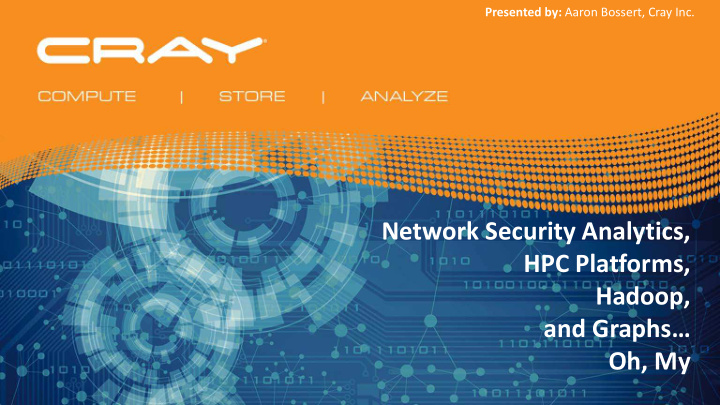



Presented by: Aaron Bossert, Cray Inc. Network Security Analytics, HPC Platforms, Hadoop, and Graphs… Oh, My
The Proverbial Needle In A Haystack Problem The Nuclear Option HPC, Hadoop, and Graphs
Problem Statement and Proposed Solutions The “Spock” Option HPC, Hadoop, and Graphs
Problem Statement and Proposed Solutions The “how we’ve been doing it” Option HPC, Hadoop, and Graphs
Problem Statement and Proposed Solutions We would like to humbly suggest bringing more workers to the party HPC, Hadoop, and Graphs
Problem Statement and Proposed Solutions Prefer a less recent pop-culture reference? HPC, Hadoop, and Graphs
Background Technologies • Urika GD – RDF triple store – proprietary architecture (XMT, XMT2) • Urika XA – Hadoop appliance – x86 based architecture • Next? • Customer needs • Massive scale • Flexibility to develop different use cases on one platform • Prevent cluster sprawl (e.g. dense racks) • Example Use Case: Network security • Near-real-time ingest • Machine learning applied to streaming and static data (e.g. IR and Forensic investigations) • Flexible framework – easy to extend and modify • “bag of tools, not a bag of hammers” (e.g. complementary technology stack to address different workloads) • Support novice to expert users (e.g. ”easy button”, if you want it; spin all the knobs if you don’t) • HPC, Hadoop, and Graphs
High-Level Architecture file-based input Apache Phoenix Interactive analysis Transform: Urika GD Threat feeds Kafka Statistical anomaly detection Network streams IR ticketing Other data sources Machine learning HPC, Hadoop, and Graphs
Architecture Highlights Credit where credit is due • Architecture is heavily based off of and influenced by Cisco OpenSOC • Changes made to take advantage of newer technologies (e.g. Apache Phoenix) • Ingest • Apache Kafka selected for high throughput • Kafka development is relatively language agnostic (i.e. lower learning curve) • Kafka handles streaming and file-based input well (assuming sufficient IO to/from disk) • Processing and machine learning • Still evaluating Kafka and Apache Storm, bulk of processing is done with Kafka for now • Existing algorithms are leveraged, new ones implemented trivially • Queries can be directed to the most appropriate tool, taking advantage of both traditional row/column and • graph store strengths to answer questions The end result • Nearly raw data stored in Phoenix for maximum flexibility • Automated and manual analytic results aggregated and used for confidence scoring • Automated alerts used to create tickets past a certain threshold • Near-real-time and forensic use cases can be supported on a single platform seamlessly • Most of the pipeline can be extended in any programming language and potentially re-use existing code • bases, lowering the bar to entry in a new environment HPC, Hadoop, and Graphs
Input Data Off the wire, from files, or both • Kafka Producers used to efficiently manage and add new data sources • Currently have parsers for the following: • Netflow • Cisco ASA • Passive DNS (collected from internal DNS servers) • Publicly available black/white lists (fetched at regular intervals based on the data source) • WHOIS • Active directory • GeoIP • DHCP • PCAP • Many more supported by Cisco OpenSOC • HPC, Hadoop, and Graphs
Scoring Suspicious behavior Anomaly detection • Track both internal and external entities on a per-entity basis • Examples of dimensions tracked • Temporal patterns (e.g. time of day, day of week, etc.) • Traffic volume • TCP/UDP port usage • Protocol usage • Existing threat data • Black/white lists • Firewall/IDS/IPS/SIEM logs • Pulling it all together • Scores are transient in the sense that they apply for a given window of time (e.g. arbitrarily by hour or by day) • Calculated across all alerting mechanisms; use weighting • Weighted entity or traffic (depending on context) score crossing a threshold is flagged for analysis/verification • Automated analytics can run side by side with ad-hoc queries • Ad-hoc analysis can be integrated into the automated workflow including replay of past traffic • Difference from standard IDS/IPS/SIEM • More complex pattern and behavior-based risk scoring based on multiple dimensions • Risk score’s temporal aspect can be used to potentially block traffic dynamically and in a more fine-grained • fashion HPC, Hadoop, and Graphs
Scoring Example Time Anomaly Weight Score 2016-01-02 13:10:02.223657 Abnormal SSH activity 2 0.2 2016-01-02 13:14:33.114538 Abnormal UDP port usage 2 0.3 2016-01-02 13:36:21.685934 Blocked traffic to blacklisted IP/domain 4 0.7 Weighted score for 2016-01-02 13 :00:00.000000 0.6 Unusual temporal activity (compared to 2016-01-03 08:44:55.300978 1 0.3 baseline) Weighted score for 2016-01-03 08 :00:00.000000 0.3 2016-01-03 10:02:31.000494 IDS alert 5 0.8 Allowed transfer to domain closely 2016-01-03 10:03:01.756002 4 0.6 associated with blacklisted IP (badRank) Weighted score for 2016-01-03 10 :00:00.000000 0.7 HPC, Hadoop, and Graphs
Graphs BadRank • Essentially a seeded PageRank score • Allows for determining guilt by association; Specifically, uses passive DNS and/or WHOIS • Centrality • Identifies bridge nodes between clusters/groups • Enables Identification of chokepoints for blocking traffic • Can be used to analyze botnet C 2 structure • Community detection • Flexible multi-dimensional similarity • Can be used to classify traffic patterns and/or hosts • Can be used to identify additional compromised/malicious entities • Summary • Graph algorithms provide a distinct class of tools not able to be easily implemented with relational data • Compliments statistical anomaly detection by providing additional dimensions • Handles joining disparate and complex datasets for enrichment • HPC, Hadoop, and Graphs
User Interface – Graphs … HPC, Hadoop, and Graphs
User Interface – Or tabular data in one UI HPC, Hadoop, and Graphs
Questions, Contact, and Further Details M. Aaron Bossert bossert@cray.com Cray Inc. HPC, Hadoop, and Graphs
Recommend
More recommend